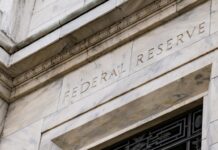
According to Eurostat’s revised economic data released on June 8, the eurozone’s gross domestic product (GDP) shrank by 0.1% month-over-month in each of the first three months of 2023. Having already declined in the last quarter of 2022, the eurozone’s economy officially slipped into recession, as this results in a Q1 GDP drop of 0.4%.
Eurozone GDP Contracted By 0.4% in Q1 2023 Year-on-Year
The eurozone fell into a mild recession after the latest data by Eurostat published on Thursday showed how GDP fell by 0.1% quarter-over-quarter in the first three months of 2023, after already dropping by the same margin in the prior three-month period. On an annual basis, the GDP of countries that use the euro as their official currency slipped by 0.4%, after previously declining in the final quarter of 2022.
While the eurozone was tipped into recession primarily due to elevated energy and food costs triggered by Russia’s invasion of Ukraine, negative economic data stemming from Germany and Ireland also played a major role. Specifically, in its initial GDP report, Eurostat estimated that the eurozone’s economy saw slight growth in Q1, however, a recession in Germany and a steep drop in Ireland’s factory output neutralized that expansion in other economies in the area.
As a result, Eurostat’s revised figures showed that the eurozone’s economy shrank for two consecutive quarters, which is in line with the formal definition of an economic recession. Meanwhile, economists believe the economy will witness growth in the quarter through June as declining energy costs relieve the pressure on local households. Still, experts expect the eurozone economy to grow just 0.9% in 2023.
US and Eurozone Inflation Still Far From Desired Targets
Even though energy expenses have declined considerably from their 2022 highs, inflation in the euro area is easing at a slow pace due to resilient food prices, limiting local consumers’ spending power. Since peaking at 10.6% in 2022, eurozone inflation fell to 6.1% in May 2023, though it still remains significantly higher than the European Central Bank’s (ECB) target of 3.2%, despite a series of interest rate hikes, which began in July last year.
“A peak in underlying inflation wouldn’t be sufficient to declare victory: we need to see convincing evidence that inflation returns to our 2% target in a sustained and timely manner. We aren’t at that point yet.”
– ECB policymaker Isabel Schnabel
Elsewhere, inflation in the US fell to 4.9% in May, after reaching a 4-decade high of 9.1% last year. The report marked the 10th consecutive month the annual inflation rate in the US has declined, but prices are still advancing at a rate that is substantially higher than the Federal Reserve’s target rate of 2% a year.
This article originally appeared on The Tokenist
Sponsored: Tips for Investing
A financial advisor can help you understand the advantages and disadvantages of investment properties. Finding a qualified financial advisor doesn’t have to be hard. SmartAsset’s free tool matches you with up to three financial advisors who serve your area, and you can interview your advisor matches at no cost to decide which one is right for you. If you’re ready to find an advisor who can help you achieve your financial goals, get started now.
Investing in real estate can diversify your portfolio. But expanding your horizons may add additional costs. If you’re an investor looking to minimize expenses, consider checking out online brokerages. They often offer low investment fees, helping you maximize your profit.






